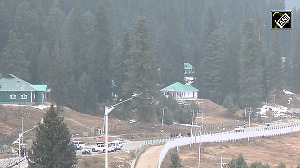Is India witnessing jobless growth or is there actually no issue with employment? The real story is between the first two suggesting that though there is sufficient employment, the challenge is to create well-paying quality jobs, says Amitabh Kant.
Illustration: Uttam Ghosh/Rediff.com

A sound policy framework requires the support of robust institutions that collect and transmit good data regularly.
I am a great believer in robust data being essential in diagnosing the right problem to target and to devise smart solutions for it.
In the context of the ongoing debate on India’s employment scenario, we need to make efforts to improve the availability of quality data so that a narrative driven debate can be resolved through objective evidence.
Currently, there are three contesting narratives.
The first narrative is of jobless growth, which implies that India is creating insufficient jobs.
The second is opposite to first and advocates that there is no issue of employment.
The third, which I believe to be true, is between the first two suggesting that though there is sufficient employment, the true challenge is to create well-paying quality jobs.
Unfortunately, the leak of data from the first year of the two-year Pilot Periodic Labour Force Survey (PLFS) conducted by the National Sample Survey Office (NSSO), before it could be fully verified, and subsequent media reports jumping to conclusions based on incomplete and half-baked data, have added confusion and misdirection to the prevalent situation rather than helping.
Being a member of the National Statistical Commission (NSC), it is my prerogative to bring the facts into public domain.
The report had neither been made available nor circulated to me for approval. The report was made available after I demanded it post the data leak controversy.
The report does not have my approval. In fact, the meeting held on December 5 to finalise the report was attended only by Acting Chairman P C Mohanan. Even, Ms J V Meenakshi was not present in the meeting.
As a standard practice, with this being the first of its kind exercise, the process of official data release should pass the most stringent scrutiny and careful verification and should definitely be subjected to peer review.
An impression has been created that the findings of the PLFS show a large jump in India’s unemployment compared to the previous Employment-Unemployment Surveys (EUS), which was last concluded in 2011-12.
This is erroneous since the previous surveys and the new PLFS cannot be so easily compared.
The PLFS is a two-year pilot started in July 2017, which includes a quarterly urban and an annual rural survey.
The objective is to have more frequent data on labour market and hence it departed from the previous EUS exercise, which happened once every five years.
Amongst other things, the PLFS has updated the sampling techniques used, a different sampling frame using 2011 Census, and adopted new data collection methods.
Let me show you how this conclusion of job loss based on comparison with 2011-12 survey data is faulty.
Besides employment data, the survey also presents the basic demographic data such as an estimate of total population in the country.
The PLFS estimates India’s total population in 2017-18 to be lower than the EUS 2011-12.
If we were to accept all such comparisons at face value, we should also be having the headline that “India’s population declines in the last 6 years”.
There is no apparent reason for population estimates to decline in six years if one considers that the methodology and coverage of the two surveys were same and that over the previous EUS surveys (2004-05, 2009-10 and 2011-12), the estimated population showed a growing trend largely in line with the country’s official population growth rate.
Another strange trend is the rate of urbanisation, which seems to have nearly stalled during 2011-12 to 2017-18.
This is at odds with what we know about growth in Indian cities from numerous credible sources - all of which point that India is fast urbanising.
India’s rapid urbanisation has been confirmed even by NASA’s satellite imagery of nightlights.
Shall we also believe that India’s urbanisation has stalled despite what empirical and anecdotal evidence shows us?
In the current debate, many argue that employment generation is happening at a slower pace than workforce growth.
However, comparison of the PLFS with the 2011-12 survey suggests that even the absolute number of people employed in the country has been declining at the rate of two million every year since 2011-12.
This is completely at odds with any other socio-economic data available.
For instance, India’s real gross domestic product (GDP) has grown by 50 per cent during this period.
Economic growth has come about with expansion in every sector - from infrastructure to housing, transport to healthcare and from professional services to retail.
It is inconceivable that such growth could happen concurrently with shrinking number of employed workforce, which would strictly imply that productivity and capital accumulation is driving whole of India’s growth.
Independent report by Brookings concluded that number of people living in extreme poverty in India has reduced from 268 million in 2011 to less than 50 million.
It would be difficult to explain how such rapid reduction can happen if unemployment is also rising rapidly.
Finally, the massive jump in unemployment seems to also contradict with another finding in the same PLFS - growing earnings and wages across different employment types.
If the labour market conditions were as poor as the unemployment rate suggests, then the economic logic would expect falling or at least stagnant wages.
But they aren’t. For example, the earnings/wages of rural women, for which unemployment rate is particularly high, have grown consistently in each quarter starting July-September 2017 and reached growth of 13 per cent and 8 per cent respectively by the last quarter.
It is overwhelmingly clear that the results from the PLFS are not comparable with the previous EUS, and the PLFS should be used strictly for measuring the changes from the baseline in 2017-18.'
We have seen this before also - doing surveys in India has always been tricky with small changes in methodology producing unexpected results.
The PLFS also highlights fall in labour force participation rate.
Even if true, it does not mention that it could be a result of other factors such as increase in attendance in school and higher education.
The problem lies with the methodology. The sample size was too small when technology could have facilitated responses from higher number of households.
In rural areas, the number of households surveyed were a mere 55,000. This has to be seen in the context of 160 million households in the country.
The percentage works out to be 0.03 per cent - about three households for every 10,000.
Even in household selection, 75 per cent weightage was given to households who have higher number of 10th pass members above 15 years.
In the present scenario there is huge probability of continuing education for above 15 years.
Most people in 15-18 group would be continuing education. Those still studying would respond in a manner that they are looking for employment.
The sample size is so small that sensitivity of the data will be very high.
In urban households one household giving wrong answer in each area will show labour force participation rate number in the range of 25 per cent.
There is no source of validation with real time data.
The surveyors used were from outsource agency - not necessarily the right person for such interaction.
Though these surveyors were provided with a tablet for recording data, they were not given SIM and data connectivity. Even locations were not captured.
I am amazed that in today’s world real time data and technology was not utilised.
Amitabh Kant is CEO of NITI Aayog. Views expressed are personal.











